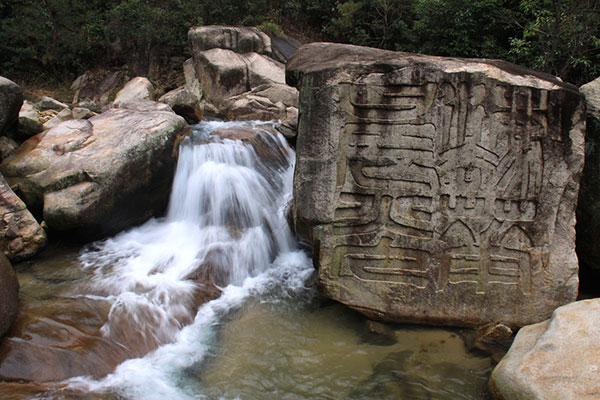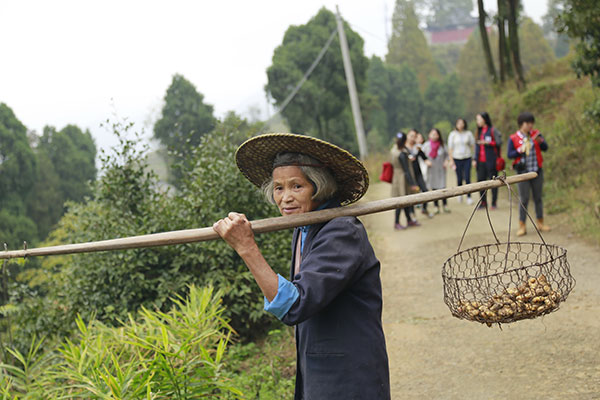
Guoqing Temple, the initial monastic site believed to be the source of the Tiantai School of Buddhism.[Photo/provided to China Daily]
Zhejiang province’s Tiantai county is celebrated as the source of what’s believed to be China’s first indigenous school of Buddhism.
Guoqing Temple in today’s Tiantai Mountains Scenic Area was the sect’s initial monastic site. It was founded by Sui Dynasty (AD 581-618) monk Zhiyi, who’s said to be the first Chinese to devise a systematic and complete Buddhist theology.
The Tiantai School peaked in the Tang Dynasty (AD 618-907) when it was exported to Japan and Korea. Many Japanese and Koreans visit today.
Resident monks live ascetic lives, worshiping and growing rice and vegetables for subsistence. These devout have heaped over 50 large bamboo baskets of rice in the Hall of the Four Heavenly Kings, the divine deities who symbolize harvest.

A Buddhist burns joss sticks to worship at Guoqing Temple. [Photo/provided to China Daily]
A yellow screen, etched with calligraphy spelling out the temple’s name, and a brick carving of a dragon shielded entrance gates in ancient times.
A pair of lions perched on marble orbs rather than blocks portray traditional gender roles. The male clamps its claws into an embroidered ball, symbolizing dominance, while the female frolics with a cub, epitomizing nurturing.
The main complex of the temple was rebuilt in 1734, under orders from Qing Dynasty (1644-1911) emperor Yongzheng. The temple boasts many precious historical relics, such as ancient Buddha statues and 18 arhats carved from golden-thread Chinese cedar.
The temple is so integral to Tiantai Buddhism that two pits, ground out by the knees of so many pious believers, pock mark the stone floor of a main hall. The hall enshrines a rotund Maitreya in front of a bronze likeness of the temple guardian, Wei Tuo. (But you have to remove a cushion to see the dimples.)

A stream with an ancient rock inscription beside it at the Shiliang Scenic Area in Tiantai county, Zhejiang province. [Photo/provided to China Daily]
About 20 kilometers away from the temple is the 6.5-square-kilometer Shiliang Scenic Area. It features streams and waterfalls gushing from granite landforms.
The first pages of the travelogue by ancient China’s Indiana Jones-explorer Xu Xiake-begin with the Tiantai Mountains and the surrounding terrain.
The Shiliang Flying Waterfall that erupts from a precipice near the range astonished the Ming Dynasty (1368-1644) sojourner, who recorded three decades of discoveries on the road in Xu Xiake’s Travels.
Xu penned prose from the Guanpu Pavilion about the main cascade that crashes 30 meters down a cliff from a natural arch.
Tang Dynasty (AD 618-907) poets traversed the rivers along Xinchang city’s Tianmu and Tiantai mountains and composed odes to their magnificence.
Given the symbiosis of geology and anthropology that define the bristling summits and surrounding expanse, the National Tourism Administration designated the Tiantai Mountains Scenic Area as a AAAAA attraction, China’s highest rating, in October.
The county then invested 810 million yuan ($123 million) to build a 10,000-square-meter tourism center, and 32,000 square meters of accommodation and shopping, to be finished in February.
The county hopes to pitch to Japanese, Korean and Southeast Asian Buddhists, who want to worship at the source of the Tiantai tradition, says its tourism-development committee’s director, Yu Changjie.
Nearby Nanping township’s 12-km-long, 1,000-year-old Nanhuang Ancient Road was once the area’s main logistics hub for salt, silk and tea. Today, it’s a perfect place for excursions.
The street isn’t far from the 666-hectare Lotus Terraced Fields.

A villager in Shantouzheng village, Nanping township. [Photo/provided to China Daily]
The proximate Shantouzheng village hosts more than 20 dilapidated buildings that are 70 to 100 years old.
The settlement hopes investors will renovate them into boutique hotels. Six have been rented out for this, and the first repurposed house, Tingsong Building, opened in October.
This could contribute to a revival of Tiantai as a destination, by bringing more explorers and pilgrims to the site hailed for its natural and supernatural splendor.
If you go
Visitors can drive or take travel buses from Zhejiang province’s Hangzhou, Ningbo or Taizhou.
